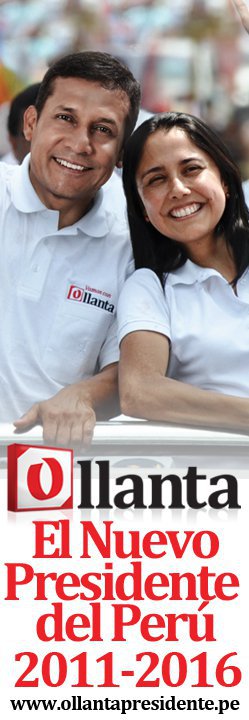On Sunday June 5th, 2011 Ollanta Humala won Peru’s national election over Keiko Fujimori by a tight margin, 51.6% to 48.4% with 95% of polls now reporting. On Monday June 6th, 2011, Peru’s stock market plunged 12.5%, the biggest decline on record. In the aftermath of Peru’s election investors are no doubt wondering, what’s next?
Humala’s campaign strategy mirrored Luiz Inacio Lula da Silva, who was elected president of Brazil in 2002 by persuading voters that his history as a union leader wouldn’t lead him to pursue anti-business policies that could damage the economy. Like Humala, Lula’s climb in the polls triggered a selloff of Brazilian bonds and stocks. But as he took office in Brazil, Lula moved quickly to reassure markets by naming FleetBoston Financial Corp. banker Henrique Meirelles as head of the central bank.
Mauricio Cardenas, director of the Latin America program at the Brookings Institution in Washington says, “Humala’s had enough time since the last election to see that Venezuela’s economy is a disaster while Lula has been a success in Brazil but markets aren’t going to give him the benefit of the doubt.”
Omar Chehade, Peru’s new Vice President-elect, said yesterday that in order to reassure Peruvians the country’s economic policies will remain in place, Humala may appoint in the coming days an ally of former President Alejandro Toledo to head the Finance Ministry. Toledo’s economic policies are described as neoliberal or strongly pro-free trade. Toledo’s pre-election support for Ollanta Humala was, considered by many, the tipping point in the campaign which delivered Humala the victory over Fujimori.
After the first round of Peru’s national elections, Gana Perú, the party led by Ollanta Humala, received 47 of the 130 congressional seats to be filled on July 28th, 2011 when the new government takes office. Before the runoff, Jorge Morel, a researcher at Instituto de Estudios Peruanos, predicted, “One scenario is that Ollanta Humala pacts with Perú Posible (Alejandro Toledo’s party), this would permit Humala to govern without problems.” The Perú Posible party will hold 21 seats in Peru’s Congress. Morel noted that informal alliances in previous parliaments were necessary when one party doesn’t control congress. “Informal alliances — that is, between individuals — have been a constant in Peruvian politics since the ’90s.”
Ben Ramsey, an analyst at JPMorgan in New York, wrote in a research note, “We would see a sharp selloff in Peru as a buying opportunity.” Adding that Peru’s local pension funds have “underweight” holdings of bonds while global investors have historically low positions in the country’s local and foreign-currency debt. Whereas, Alberto Bernal, head of research at BullTick Capital Markets in Miami says, “My sense is that … investors will be on the defensive. That kind of uncertainty is going to take a toll on the economy. I think Peru is going to lose at least a couple of quarters of investment.”
As reported by the Globe and Mail, TSX mining executives have their theories as well. David Garofalo, HudBay Mineral’s President & CEO, said in response to Monday’s selloff, “I think it’s a bit hysterical, frankly. He’s no Chavez … Peru has been a wide-open market economy for 20 years. So, the prospect of him nationalizing things is ludicrous.” Andrew Swarthout, CEO of Bear Creek Mining, pointed out that the industry is expecting some form of tax hike or royalty increase, up from the current rates of 30% and 3% respectively. “The current royalty structure is quite favourable and there’s room for discussion, especially given these commodity prices we’ve seen for the last five to 10 years,” Mr. Swarthout said.
Investors in Peru long TSX mining stocks have been battered since Humala’s first round victory on April 10th, 2011. Prior to the post-election selloff, a basket of 10 Canadian listed miners doing business in Peru was already down 18.9% in the days leading up to the runoff between Humala and Fujimori. In comparison, Compania De Minas Buenaventu (NYSE: BVN), the largest owner of mining rights in Peru, closed trading at $43.45 on April 8th, 2011 and, today, is currently trading at $36.09. This marks a cumulative decline in Compania de Minas’ share price of 16.9% since the Humala effect hit the Peruvian markets by storm.
Nationalist, radical, leftist. These are the labels that were thrown at Ollanta Humala before the results of Peru’s second round election gave him a new label: President-elect. So who is Ollanta Humala? A backwards iron-fisted dictator ready to plunge Peru into an economic abyss or another left-of-center South American leader trying to improve the quality of life for his nation’s poor? Only time will tell. In the meantime, you can join his Facebook page or follow him on Twitter.




 Follow us on Twitter
Follow us on Twitter Become our facebook fan
Become our facebook fan











Comments are closed.